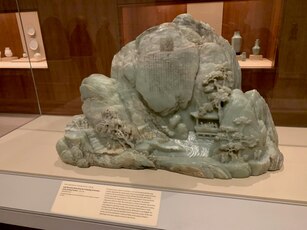Jade Mountain Illustrating the Gathering of Scholars at the Lanting Pavilion
[1] It was made under the fifth emperor of the dynasty, Qianlong,[2] who commissioned this sculpture, which “remains the largest jade carving outside of China”.
"[3] According to Gihring, Walker started Minnesota's first art gallery in his own home, and this jade carving was next displayed there.
It also includes what looks like a pagoda with little human figures that may be praying, depicting a scene from Asian culture.
[5] According to the Minneapolis Institute of Art, it represents "tranquility and harmony of otherworldliness and the longing of the cultivated individual to escape the mundane world to commune with nature.
[5] Historically, jade was thought to have magical properties and was believed to grant its owner immortality.
[1] Jade was hard to find in China, and its rarity may help explain its popularity as a gemstone.
In its center, it tells the story about a historical event called the Spring Purification Festival, which during the Qing dynasty took place on the third day of the third lunar calendar month.
At some point, the people would dip their hands in the water to help prevent bad luck.
There was a “drinking contest”, when people sent wine goblets floating down the winding creek, everyone cheering along on the bank.
To commemorate this day, the calligrapher Wang Xizhi wrote an introduction to the poems collected on the Jade Mountain carving.
The festival and the poems created during this event helped inspire many scholars and artists alike.
Elders and youth alike congregated at this literary meeting, it was in the Yonghe reign, and the final month of spring.
Often the calligraphy [of Lanting Xu] is scrutinized over its authenticity, I enjoy the genuineness of the picture of jade.





